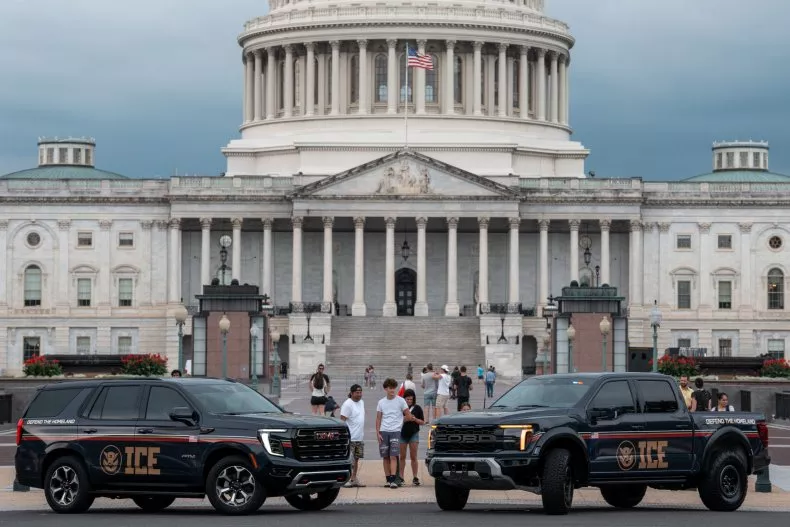Since the start of the year, the number of foreign-born people in the United States has decreased by almost 2 million, which has sparked worries that labor-intensive industries like construction may soon see severe shortages in their workforce.
The right-leaning Center for Immigration Studies recently analyzed statistics from the Bureau of Labor Statistics and found that the U.S. foreign-born population declined by 2.2 million between January and July, the largest six-month fall ever. While the number of naturalized citizens increased little, the decline was solely caused by noncitizens.
According to estimates, the number of illegal immigrants decreased from 15.8 million in January to 14.2 million, a decrease of 1.6 million, or 10%. Latin American noncitizens who arrived after 1980—a category frequently associated with illegal immigration—decreased by 10%, according to the center.
The paper did concede, though, that more stringent immigration enforcement during the Trump administration might have also discouraged immigrants from identifying as foreign-born in surveys such as the monthly Current Population Survey, which takes a sample of roughly 60,000 homes in the United States.
The results were made public shortly before Kristi Noem, the secretary of the Department of Homeland Security (DHS), stated that since President Trump took office again in January, 1.6 million illegal aliens have fled the nation.
According to Noem, 1.6 MILLION illegal immigrants have fled the US in less than 200 days. This is enormous. Better job prospects for Americans, safer streets, less strain on hospitals and schools, and savings for taxpayers are all benefits of this. President Trump, thank you!
According to the DHS, the country is already experiencing the effects of this sharp drop in the number of illegal immigrants, including less demand on public services and a recovery in local labor markets.
Potential Economic Risks
The Pew Research Center estimates that over 30 million immigrants worked in the United States in 2022. Of those, 8.3 million were undocumented laborers and 22.2 million were legal immigrants.
Some industries rely heavily on immigrants. One in four construction workers in the country are immigrants, according to the National Association of Housebuilders. In California, noncitizens make up 41% of construction workers, compared to 38% in Florida and Texas and 37% in New York.
Although some people think that fewer immigrants benefit American-born workers, experts caution that the economy could become unstable due to the quick loss of manpower. According to the analysis, fewer workers might contribute to higher salaries for legal immigrant workers without college degrees and U.S.-born workers, but the abrupt decline might cause major disruptions.
The CEO of VISIONS, a nonprofit organization dedicated to fairness and inclusion, Erika Dagestan, warned Newsweek that sectors like construction, agriculture, healthcare, hospitality, and services would face shortages right away.
Long-term repercussions will also be felt in highly skilled industries, including as higher education, technology, and research, where immigrants are heavily represented, Dagestan continued. Decreased inflows result in fewer workers in critical positions as well as fewer entrepreneurs, educators, and innovators.
If companies are unable to recruit enough workers, building delays could become prevalent, according to Nicole Gunara, principal immigration lawyer at Manifest Law. She pointed out that other firms and industries that depend on the timely completion of such projects may be negatively impacted by these delays.
The CEO of the US Hispanic Business Council, Javier Palomarez, cautioned that the effects would be disastrous, pointing out that immigrants not only pay high taxes but also hold important positions in construction, logistics, and agriculture.
According to Palomarez, it is just not feasible to rely on domestic labor to perform those tasks, particularly in sectors like agriculture.
Dagestan concurred, pointing out that many jobs held by immigrants are ones that American-born workers have traditionally shunned because of low wages, difficult working conditions, or geographical difficulties. “Training pipelines move too slowly to replace lost immigrant workers, even in highly skilled industries,” she said.
The American View on Immigration
President Trump has made reducing immigration, particularly illegal immigration, a primary focus. Illegal border crossings have drastically decreased since the start of his second term in January, but ICE arrests have increased by more over 200 percent through June 2025.
According to data, President Trump has established the safest border in the country’s history, Thomas D. Homan, the border czar, wrote on X in July. This is the lowest amount we have ever seen. Never.
On the other hand, public opinion presents a different picture. According to a July AP-NORC poll, just 43% of Americans were satisfied with Trump’s immigration policies.
According to Gallup, Americans’ views on immigration have improved over time, with only 30% of them now wanting to see a reduction in immigration, down from 55% in 2024. Currently, a record 79 percent of Americans believe that immigration benefits the nation.
According to Gallup, as illegal border crossings decline, more Americans support pathways to citizenship for undocumented immigrants already residing in the country, while fewer support strict enforcement tactics.












